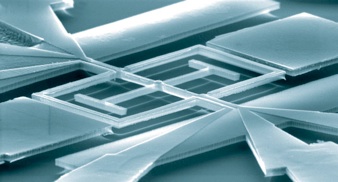Nanoelectronic devices—-ultra small electronic structures, even smaller than one of the 1 billion devices in the current Intel microprocesser chip, because of their small size and large surface-to-volume ratio, enable innovative measurements of the surface charge profile of the nanowire conduction channel. Using these nano-channel devices, we have been able to detect hydrogen ions (pH), glucose, protein and—-more importantly, cancer-specific biomarkers at a level relevant for clinical use. We continue to build more sophisticated nanowire field effect transistors with complex circuits, designed to take advantage of much more advanced on-chip signal processing.
Selected Publications
Nanoelectronic detection of breast cancer biomarker, Appl. Phys. Lett., 97 (23), 233702 (2010), APL
Synchronized oscillation in coupled nanomechanical oscillators, Science 316, 95 (2007), Science local pdf
Silicon-based nanochannel glucose sensor, Appl. Phys. Lett. 92, 013903 (2008), APL local pdf
Nanoscale field effect transistors for biomolecular signal amplification, Appl. Phys. Lett. 91, 243511 (2007), APL local pdf
Coherent signal amplification in bistable nanomechanical oscillators by stochastic resonance, Nature 437, 995 (2005), Nature local pdf
Nanomechanical detection of itinerant electron spin flip, Nature Nanotechnology 3, 720 (2008), Nature Nanotech.
For all publications, click here






